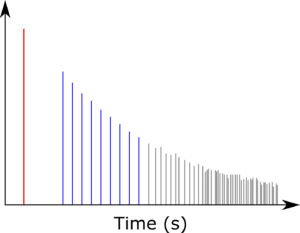The impulse response has become the standard measurement to describe an acoustic environment. The space is assumed to be a linear time-invariant (LTI) system. The properties of an LTI allow auralization using linear convolution as well as analysis. The measured room impulse response (RIR) is divided into direct sound, early reflections, and late reflections. Each section has acoustic parameters that connect the objective measurement and design of the venue to the subjective experience of the listener. There are also parameters from the performer’s perspective, which focus on the acoustics of the stage. Here, we will have a brief overview of a few metrics used to evaluate the performance of an acoustic venue from the perspective of the listener.
For the direct sound of the RIR, there is the initial time delay gap. It describes the time difference between the direct sound and the first early reflection. It is directly proportional to the width of the venue, allowing the measurement to represent the size of the acoustic venue. Due to the position dependence of the measurements, it is often measured from the center of the room.
Early reflections are associated with music loudness, speech intelligibility, and clarity. Acoustic parameters definition, clarity, lateral fraction, and early interaural cross-correlation (IACC) aim to quantify the early reflections. Definition and clarity use omnidirectional microphones to measurement ratios of early-to-total energy and early-to-late energy. Lateral fraction and early IACC use pressure gradient and binaural measurements to quantify the spaciousness and apparent source width using early reflections.
Lastly, we study the effects of the late reflections. Reverberation and early decay (EDT) time illustrate the statistical portion of the impulse response. Although EDT is more closely related to the listener’s perception of reverberation, it is also affected by the early reflections of the RIR. There are many methods to measure reverberation time, including linear and nonlinear regression models. Sabine and Erying also developed well-known equations to estimate reverberation time. Both take advantage of reverberation times direction proportionality to volume and reflective surfaces. They also share the underlying assumptions of a diffuse field and evenly distributed absorption.

early reflections (blue), and late reflections
(grey) of room impulse response